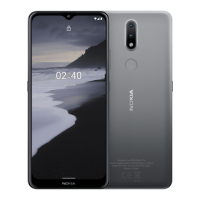
Do you have a question about the Nokia 2.4 and is the answer not in the manual?
| Color name | Charcoal |
|---|---|
| Form factor | Bar |
| Screen shape | Flat |
| Display diagonal | 6.5 \ |
| Touchscreen type | Capacitive |
| Display resolution | - pixels |
| Rounded display corners | Yes |
| Processor model | Helio P22 |
| Processor family | MediaTek |
| Processor frequency | - GHz |
| RAM capacity | 2 GB |
| Compatible memory cards | MicroSD (TransFlash) |
| Maximum memory card size | 512 GB |
| Internal storage capacity | 32 GB |
| Rear camera type | Dual camera |
| Front camera type | Single camera |
| Rear camera resolution (numeric) | 13 MP |
| Front camera resolution (numeric) | 5 MP |
| Second rear camera resolution (numeric) | 2 MP |
| 3G standards | - |
| SIM card type | NanoSIM |
| Wi-Fi standards | 802.11b, 802.11g, Wi-Fi 4 (802.11n) |
| Bluetooth version | 5.0 |
| SIM card capability | Dual SIM |
| Mobile network generation | 4G |
| Subscription type | No subscription |
| USB connector type | Micro-USB |
| Headphone connectivity | 3.5 mm |
| Multimedia Messaging Service (MMS) | Multimedia Messaging Service (MMS) is a standard way to send messages that include multimedia content to and from a mobile phone over a cellular network |
| Wireless charging | No |
| Platform | Android |
| Virtual assistant | Google Assistant |
| Operating system installed | Android 10.0 |
| Talk time (3G) | - h |
| Battery capacity | 4500 mAh |
| Harmonized System (HS) code | 85171300 |
| Depth | 8.69 mm |
|---|---|
| Width | 76.3 mm |
| Height | 165.85 mm |
| Weight | 189 g |
Identification and description of the phone's physical buttons, ports, and components.
Step-by-step guide for inserting SIM and memory cards into the phone's tray.
Instructions for connecting the charger and charging the device's battery.
Guide to powering on the device for the first time and completing initial setup.
Steps to transfer data from an old phone to your new Nokia 2.4 using Google account.
Tips and settings to conserve battery power and extend usage time.
Instructions for initiating, receiving, and declining phone calls.
Using Google Maps to locate businesses, addresses, and get driving directions.
Configuring automatic backups for device data, settings, and app information.
Setting up a screen lock (PIN, pattern, password) for device security.
Registering and using fingerprint recognition for unlocking the phone.
Setting up and using facial recognition to unlock the device.
Essential safety guidelines and precautions for using the device.
When and where to turn off the device to prevent interference or danger.
Guidelines for safe driving and operating the vehicle while using the phone.
Advice on preventing hearing damage from loud audio playback and headset use.
Instructions and critical information for making emergency calls on the device.
Precautions for keeping the device and its small parts away from children.
Information on potential interference between the device and medical equipment.
Specific precautions for users with implanted medical devices to prevent interference.
Warning about headset use affecting awareness of surroundings and hearing.
Instructions to switch off the device in environments with a risk of explosion.